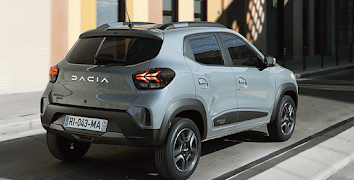The Dacia Spring, the cheapest electric car, gets a power boost to 65 hp along with some technical improvements. Here are our driving impressions. Some might say the base version was enough, and we wouldn’t disagree; for urban use, the Spring, as we knew it, had enough pep at traffic lights. However, the new variant adds even more versatility to this Romanian car produced in China, with faster acceleration, better range, and improved overtaking capabilities.

The numbers? The 0 to 100 km/h time drops from 19.1 to 13.7 seconds with this engine. Overtaking is also improved: the 80 to 120 km/h time is reduced to 13.5 seconds from 26.6 seconds. Overtaking slower vehicles is now smoother. The only thing unchanged is the top speed, still capped at 125 km/h. But in a Spring, that’s already a decent pace. The cheapest electric city car on the market hasn’t addressed its flaws, still sporting the mediocre Linglong tires with poor grip on dry surfaces and almost no performance on wet roads. This remains the main downside of this Dacia, which can feel unstable and hesitant, unusually tricky for a modern car, especially in the rain and at higher speeds. Fortunately, its traction control system helps keep it on track.
At Dacia, perhaps to reassure journalists at these test drives, they mentioned a study showing that the Springs sold so far average just 31 kilometers per day and run at an average speed of 26 km/h. However, the study doesn’t say if the owners use the vehicle when it rains…
The small Dacia has taken advantage of the spring to replace its shock absorbers across the range and adopt new steering tuning.
The new shock absorbers better control body movements and improve stability, but they are still a bit too soft on the road and slightly stiff in the city. The suspension is now acceptable but nothing more, which is already an improvement.
As for the steering, it offers more firmness at the center, reducing the slight but constant corrections the Spring required to stay in a straight line. It’s still not perfect, with insufficient feedback, but the improvement is noticeable.
In summary, these changes are all welcome. However, the increased power, while appreciated, remains somewhat paradoxical. With its still-limited road performance, a Spring is better suited for city driving.
There, it remains highly maneuverable, narrow, short, and light, excelling in its environment. Its quietness and discreet nature almost make you forget its charm-free aspects, exotic origins, basic presentation, and cost-cutting materials. Yet, the equipment is serious, with a touchscreen, GPS, air conditioning, Bluetooth, and a rearview camera.
Externally, this Spring looks quite attractive in its new Extreme trim, the only one available with this engine, featuring a Slate Blue color (€550) along with dark rims and copper-colored accents as standard.
Priced at €22,850, it offers an appealing proposition, being “only” €750 more expensive than the 45 hp Spring Expression, which still has its own merits.
You can expect a theoretical range of 220 kilometers (305 km in urban driving), perfectly suited to this city car’s size, powered by a 26.8 kWh usable battery weighing 188 kg.
For home charging, which three-quarters of owners do (according to Dacia), the car can be fully charged in about 12 hours on a standard garage socket and overnight on a reinforced plug.
This means that installing a WallBox at home isn’t even necessary, depending on how you use the Spring.
But for longer trips, an optional €600 package includes a built-in 30 kW DC charger, which, with a compatible cable (€250) and a fast charger, allows an 80% charge in one hour.
Dacia Spring 65 – Our impressions: The small Romanian car retains its strengths but also its major flaws. While still affordable, this power boost breathes new life into the Spring.
Dacia Spring 65: What’s new under the hood?
To increase power from 33 kW to 48 kW, the Spring’s permanent magnet synchronous motor has undergone several modifications, including an increase in the number of coils on the stator.
The motor bearings have also been reinforced, while the rotational speed has been increased. The base Spring’s rotor can reach 8,200 rpm, while the new version can go up to 14,700 rpm.
The engine torque drops from 125 Nm to 113 Nm, but the all-new gearbox has more teeth on each gear, giving the Spring 65 more “wheel torque” than the Spring 45 (672 Nm vs. 452 Nm).
Advantages:
– Improved performance
– Attractive price/equipment ratio
– Maneuverability and ease of use
Disadvantages:
– Poor quality tires
– Road behavior
– Finish and presentation
Technical Specifications (Dacia Spring Electric 65):
Starting price: €22,300
Tested consumption (kWh/100 km): 14.7 WLTP
Mixed consumption (kWh/100 km): 14.5
CO2 emissions (g/km)/Government subsidy: 0/€5,000
Tax horsepower: 2 CV
Country of manufacture: China
Warranty: 3 years/100,000 km
Battery warranty: 8 years/120,000 km
Motor: Permanent magnet synchronous electric motor
Transmission: Front-wheel drive, single-speed
Power (kW/hp): 48/65
Torque (Nm): 113
Battery: Lithium-ion, 26.8 kWh usable capacity
Charging time: Domestic 2.3 kW: 13.5 hours
Reinforced socket 3.7 kW: 8.5 hours
WallBox 7.4 kW: 4.8 hours
Fast charger (30 kW, optional): 1 hour (0-80%)
Curb weight (kg): 975
Length x width x height (m): 3.73 x 1.58 x 1.51
Wheelbase (m): 2.42
Turning diameter (m): 9.5
Top speed (km/h): 125
0 to 100 km/h (s): 13.7
Tires during the test: 165/70 R 14 – Linglong Green-Max HP 050
Front/rear elbow room (cm): 128/125
Rear legroom (cm): 63
Trunk capacity 4 seats/2 seats (l): 270/620
Tested version price: €23,450 (with options)
Dacia Spring: Electric Range, 33 kW to 48 kW, from €20,800 to €22,300
Dacia Spring 65: Available options:
Spare wheel (€200)
30 kW DC charger (€600)
Mode 3 Type 2 cable (€250)
Dacia Spring 65: Main competitors:
Renault Twingo E-Tech, electric, 81 hp, starting at €25,250
Leapmotor T03, electric, 109 hp, starting at €25,990
Volkswagen ID.2 All, not yet available, under €25,000

